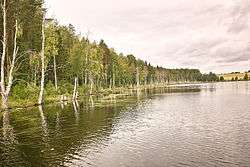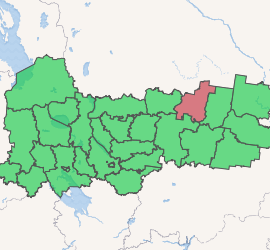Tarnogsky District
Tarnogsky District (Russian: Та́рногский райо́н) is an administrative[1] and municipal[7] district (raion), one of the twenty-six in Vologda Oblast, Russia. It is located in the northeast of the oblast and borders with Ustyansky District of Arkhangelsk Oblast in the north, Nyuksensky District in the east, Totemsky District in the south, and with Verkhovazhsky District in the west. The area of the district is 5,200 square kilometers (2,000 sq mi).[4] Its administrative center is the rural locality (a selo) of Tarnogsky Gorodok.[3] District's population: 12,838 (2010 Census);[5] 15,363 (2002 Census);[9] 17,402 (1989 Census).[10] The population of Tarnogsky Gorodok accounts for 41.8% of the district's total population.[5]
Tarnogsky District Тарногский район | |
|---|---|
 A lake near Tarnogsky Gorodok | |
.png) Flag  Coat of arms | |

Location of Tarnogsky District in Vologda Oblast | |
| Coordinates: 60°30′N 43°33′E | |
| Country | Russia |
| Federal subject | Vologda Oblast[1] |
| Established | January 25, 1935[2] |
| Administrative center | Tarnogsky Gorodok[3] |
| Area | |
| • Total | 5,200 km2 (2,000 sq mi) |
| Population | |
| • Total | 12,838 |
| • Estimate (2018)[6] | 11,398 (-11.2%) |
| • Density | 2.5/km2 (6.4/sq mi) |
| • Urban | 0% |
| • Rural | 100% |
| Administrative structure | |
| • Administrative divisions | 13 selsoviet |
| • Inhabited localities[3] | 265 Rural localities |
| Municipal structure | |
| • Municipally incorporated as | Tarnogsky Municipal District[7] |
| • Municipal divisions[7] | 0 Urban settlements, 6 Rural settlements |
| Time zone | UTC+3 (MSK |
| OKTMO ID | 19642000 |
| Website | http://tarnoga-region.ru/ |
Geography
The district is located at the divide between the Sukhona and the Vaga Rivers and belongs thus to the Northern Dvina's basin. The Sukhona forms the southeastern border of the district. The northeastern part of the district lies in the basin of the Uftyuga River, the left tributary of the Sukhona. The Uftyuga, as well as its main tributary the Sulonga, flow through the district. The rivers in the central, northern, and western parts of the district flow into the Kokshenga River, the right tributary of the Vaga. The main tributaries of the Kokshenga within the district are the Ileza and the Uftyuga (a different one from the tributary of the Sukhona).
Almost the whole of the district is covered by coniferous forests (taiga). The exception are the meadows in the floodplains.
History
The area was originally populated by the Finno-Ugric peoples and then colonized by the Novgorod Republic. Novgorod merchants used the Sukhona River as one of the main waterways leading to the White Sea and the Pechora. Already in the 12th century, Totma and the surrounding areas were under Novgorod's control. After the fall of Novgorod, the area became a part of the Grand Duchy of Moscow. Tarnogsky Gorodok was first mentioned in the chronicles in 1453.[2] The area produced crops, and the Kokshenga and the Vaga were used to transport bread to Arkhangelsk.
In the course of the administrative reform carried out in 1708 by Peter the Great, the area was included into Vazhsky Uyezd of Archangelgorod Governorate. In 1780, the governorate was abolished and transformed into Vologda Viceroyalty. The latter was abolished in 1796, and the part of it which included Tarnogsky Gorodok became Vologda Governorate. The area became a part of Totemsky Volost with the seat in Totma. In the 1890s, Tarnogsky Gorodok became the seat of Shevdenitskaya Volost.[2]
On July 15, 1929, several governorates, including Vologda Governorate, were merged into Northern Krai, and the uyezds were abolished. Instead, Kokshengsky District with the administrative center in the selo of Tarnogsky Gorodok was established as a part of Vologda Okrug. It included parts of the former area of Totemsky Uyezd. On July 30, 1931, Kokshengsky District and the neighboring Sukhonsky District were abolished, and Nyuksensky District with the administrative center in the selo of Nyuksenitsa was established. On January 25, 1935, Tarnogsky District with the administrative center in Tarnogsky Gorodok was established on the territories formerly in Nyuksensky and Totemsky Districts.[2] In the following years, the first-level administrative division of Russia kept changing. In 1936, Northern Krai was transformed into Northern Oblast. In 1937, Northern Oblast itself was split into Arkhangelsk Oblast and Vologda Oblast. Tarnogsky District remained in Vologda Oblast ever since with the exception of the short period in 1962-1965, when some of the districts were merged.
Economy
Industry
The economy of the district is based on timber industry.[11] Food industry is also present; in particular, there is a butter factory in Tarnogsky Gorodok and a food factory in the selo of Krasnoye.
Agriculture
There are sixteen farms in the district: thirteen of them produce milk, two produce meat, and one produces eggs.[12]
Transportation
Tarnogsky Gorodok stands on the paved road connecting Oktyabrsky in Arkhangelsk Oblast in the north with Totma in the south and Veliky Ustyug in the east. A short stretch of the road connecting Vologda and Veliky Ustyg runs within the limits of the district along the left bank of the Sukhona. There also local roads in the district. There is regular passenger bus service originating from Tarnogsky Gorodok.
While the Sukhona is navigable within the district, there is no passenger navigation.
Tarnogsky Gorodok was served by the Tarnogsky Gorodok Airport which is currently defunct.[13]
Culture and recreation
The district contains 4 objects classified as cultural and historical heritage by the Russian Federal law, and additionally 123 objects classified as cultural and historical heritage of local importance.[14] Most of these are wooden farms and churches built prior to 1917.
The objects protected at the federal level are:
- The Potsky Pogost, in the village of Kaplinskaya, consisting of the wooden St. George Church (1700) and the brickstone St. Iliya Church (1858). The wooden church was moved to the Semyonkovo Open Air Museum, whereas the brickstone church is very much neglected.
- The All Saints Church in the village of Baklanovskoye (18th century); no longer exists.
The only state museum in the district is the Museum of Traditional Folk Culture in Tarnogsky Gorodok.[15] The ethnographic department of the museum is located in the village of Zarechye.[16]
Artist Dzhanna Tutundzhan lived in the village of Sergiyevskaya from the 1960s until her death in 2011, and many of her canvasses were inspired by the surrounding landscapes.[17]
References
Notes
- Law #371-OZ
- Историческая справка (in Russian). Администрация Тарногского муниципального района. Retrieved August 30, 2011.
- Resolution #178
- Характеристика района (in Russian). Администрация Тарногского муниципального района. Retrieved August 30, 2011.
- Russian Federal State Statistics Service (2011). "Всероссийская перепись населения 2010 года. Том 1" [2010 All-Russian Population Census, vol. 1]. Всероссийская перепись населения 2010 года [2010 All-Russia Population Census] (in Russian). Federal State Statistics Service.
- "26. Численность постоянного населения Российской Федерации по муниципальным образованиям на 1 января 2018 года". Federal State Statistics Service. Retrieved January 23, 2019.
- Law #1123-OZ
- "Об исчислении времени". Официальный интернет-портал правовой информации (in Russian). June 3, 2011. Retrieved January 19, 2019.
- Russian Federal State Statistics Service (May 21, 2004). "Численность населения России, субъектов Российской Федерации в составе федеральных округов, районов, городских поселений, сельских населённых пунктов – районных центров и сельских населённых пунктов с населением 3 тысячи и более человек" [Population of Russia, Its Federal Districts, Federal Subjects, Districts, Urban Localities, Rural Localities—Administrative Centers, and Rural Localities with Population of Over 3,000] (XLS). Всероссийская перепись населения 2002 года [All-Russia Population Census of 2002] (in Russian).
- "Всесоюзная перепись населения 1989 г. Численность наличного населения союзных и автономных республик, автономных областей и округов, краёв, областей, районов, городских поселений и сёл-райцентров" [All Union Population Census of 1989: Present Population of Union and Autonomous Republics, Autonomous Oblasts and Okrugs, Krais, Oblasts, Districts, Urban Settlements, and Villages Serving as District Administrative Centers]. Всесоюзная перепись населения 1989 года [All-Union Population Census of 1989] (in Russian). Институт демографии Национального исследовательского университета: Высшая школа экономики [Institute of Demography at the National Research University: Higher School of Economics]. 1989 – via Demoscope Weekly.
- Ведущие предприятия района (in Russian). Tannogsky Gorodok: Администрация Тарногского муниципального района. Retrieved August 30, 2011.
- Сельское хозяйство (in Russian). Администрация Тарногского муниципального района. Retrieved August 30, 2011.
- Транспорт (in Russian). Администрация Тарногского муниципального района. Retrieved August 31, 2011.
- Памятники истории и культуры народов Российской Федерации (in Russian). Russian Ministry of Culture. Retrieved June 2, 2016.
- Музей традиционной народной культуры (in Russian). Российская сеть культурного наследия. Retrieved August 30, 2011.
- Достопримечательности (in Russian). Администрация Тарногского муниципального района. Retrieved August 30, 2011.
- Шеваров, Дмитрий (February 24, 2011). Любимое окно Джанны Тутунджан. Rossiyskaya Gazeta (in Russian) (5414 (38)).
Sources
- Законодательное Собрание Вологодской области. Закон №371-ОЗ от 4 июня 1999 г. «О вопросах административно-территориального устройства Вологодской области», в ред. Закона №2916-ОЗ от 7 декабря 2012 г. «О внесении изменений в Закон области "О вопросах административно-территориального устройства Вологодской области"». Вступил в силу со дня официального опубликования. Опубликован: "Красный Север", №124–125, 29 июля 1999 г. (Legislative Assembly of Vologda Oblast. Law #371-OZ of June 4, 1999 On the Matters of the Administrative-Territorial Structure of Vologda Oblast, as amended by the Law #2916-OZ of December 7, 2012 On Amending the Oblast Law "On the Matters of the Administrative-Territorial Structure of Vologda Oblast". Effective as of the day of the official publication.).
- Правительство Вологодской области. Постановление №178 от 1 марта 2010 г. «Об утверждении реестра административно-территориальных единиц Вологодской области», в ред. Постановления №686 от 25 июня 2012 г. «О внесении изменений в некоторые Постановления Правительства области». Вступил в силу 20 марта 2010 г. Опубликован: "Красный Север", №29, 20 марта 2010 г. (Government of Vologda Oblast. Resolution #178 of March 1, 2010 On Adopting the Registry of the Administrative-Territorial Units of Vologda Oblast, as amended by the Resolution #686 of June 25, 2012 On Amending Various Resolutions of the Oblast Government. Effective as of March 20, 2010.).
- Законодательное Собрание Вологодской области. Закон №1123-ОЗ от 6 декабря 2004 г. «Об установлении границ Тарногского муниципального района, границах и статусе муниципальных образований, входящих в его состав», в ред. Закона №2809-ОЗ от 5 июля 2012 г. «О внесении изменений в отдельные Законы области, устанавливающие границы и статус муниципальных образований области». Вступил в силу через 10 дней со дня официального опубликования. Опубликован: "Красный Север", №242, 11 декабря 2004 г. (Legislative Assembly of Vologda Oblast. Law #1123-OZ of December 6, 2004 On Establishing the Borders of Tarnogsky Municipal District, on the Borders and Status of the Municipal Formations It Comprises, as amended by the Law #2809-OZ of July 5, 2012 On Amending Various Laws of the Oblast, Establishing the Borders and the Status of the Municipal Formations of the Oblast. Effective as of after 10 days from the day of the official publication.).